Though I risk putting myself up for intense mockery, I must get this confession out of the way immediately:
I cried during Shirobako.
It was the arc during episodes 7 and 8, where Ema Yasuhara is struggling with her craft as a key animator. She wants to do good quality work, but she has to learn to do things quickly, because the production is falling behind schedule and deadlines are cruel in the world of making anime. But the people checking her are unhappy with her work, asking her to redo it. She just can’t seem to get it right to her and their satisfaction, and she’s terrified, because not delivering something acceptable means that people won’t give her more work. She wants to be proud of her work, she wants others to like her work, but her own self-doubts and frustration and a looming deadline are crushing her. All she wants to do is make a living off the creative work she loves, but now she’s doubting her ability to do that.
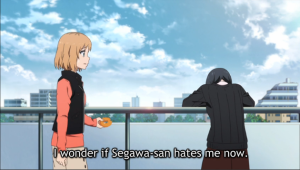 I cried alongside her as she voiced her fears to the lead character, Aoi Miyamori. I knew how she felt. I’d been where she was many times over. Sometimes I still find myself feeling like her. It’s a scary, scary place to be, and here it felt all too real. Even as I was watching it again to get screens for this article, it felt like a gut-punch: seeing her just barely holding it together in front of Aoi and going into full-blown panic after she steps away.
I cried alongside her as she voiced her fears to the lead character, Aoi Miyamori. I knew how she felt. I’d been where she was many times over. Sometimes I still find myself feeling like her. It’s a scary, scary place to be, and here it felt all too real. Even as I was watching it again to get screens for this article, it felt like a gut-punch: seeing her just barely holding it together in front of Aoi and going into full-blown panic after she steps away.
This is one of the many reasons why Shirobako is such a terrific show: the emotional highs and lows of the characters resonate with anyone who has ever gone to work in a field they were starry-eyed over. It’s a show about following your dreams, seeing the reality of those youthful dreams firsthand, and struggling to come to terms with exactly why you’re following those dreams.
It’s an anime about people who make anime.
Miyamori Aoi and her classmates in high school were in the animation club, where they made a rudimentary short animated film for their school festival. The five girls promise each other that they’ll work together again someday in Tokyo. Flash forward to a few years later, where Miyamori and her fellow club member, Ema Yasuhara, have gotten jobs at Musashino Animation, a long-established studio that has had a rough time in its newer productions. Their newest series, Exodus!, has a lot riding on it. As Aoi and Ema bust their butts working on a show that seems to be falling further and further behind schedule, the other three girls all have their own hurdles to overcome: Misa Todo is at a 3D modeling job that pays well but is creatively unfulfilling, Shizuka Sakaki is still struggling to break into voice acting, and the young Midori Imai won’t be able to join her clubmates until she’s done with college.
While there’s time spent on the stories of each of the five girls – and occasional bits with some other supporting characters – Shirobako is by and large Aoi’s show, and she manages to carry it nicely. While Aoi is diligent and hardworking, she’s also relatively inexperienced and doesn’t really have a goal for her career in mind besides “working in animation.” Seeing her workmates at Musashino often makes her doubt her capabilities and motivations. She has two beloved childhood dolls, a bear named Roro and an odd goth-loli named Mimuji, that serve as the Greek Chorus for her inner thoughts in sequences that are a bit jarring at first but do a good job of presenting the character’s personal conflict.
Aoi is currently working as a production assistant on Exodus!, and the amount of crap she has to deal with starts off high and never quite lets up. Her fellow production assistant neglects to tell the office that the latest episode is missing keyframe animation. The director, who is very obviously based on real-life anime director Seiji Mizushima, gets very picky over certain details and is over a month late on creating the plot and storyboards for the show’s final episode. A 2D and a 3D animator get into a spat over how best to do a scene over miscommunication, and one threatens to abandon the project entirely. Things get even more complicated when Musashino signs on to create a show based on a hit manga, as editors and outside corporate figures begin to meddle with the production’s direction in very trying ways.
While a lot of the events in Shirobako are exaggerated for comic and/or dramatic effect, there’s a lot of truth behind the situations presented here: seemingly endless meetings that pit one person with a vested interest against another, having to wrangle a bunch of creative eccentrics who don’t always get along and might not see the point in what you’re doing, executives that seem to want to deliberately screw with your project to get their own power-trip highs, finicky creators who demand last-minute changes that completely destroy the project schedule, and so on. It’s not hard to see a lot of parallels within the game industry (or really, any creative industry) in the difficulties the crew at Musashino has to face; In fact, a lot of similar production stress, office power-tripping, and idiotic executive meddling happens in game creation. It’s said that a lot of people in the anime industry burn out fairly quickly and those who stick around are the “lifers”… which really doesn’t seem all too far removed from the AAA development environment that chews through young talent rapidly.
Which leads Aoi to the question of why she’s even doing all of this. She grew up loving anime, of course, and dreamed about making anime, but is she truly sure that this is the career life she wants? It’s a struggle many in creative industries have faced under stress. In contrast, her former clubmate Misa has a cushy job at a famous 3D modeling company, where she’s spent the last several months modeling car tires… and appears to be doing nothing but car models for the foreseeable future. It’s an easy, low-stress job with fantastic benefits, but it’s creatively unrewarding. Is a comfortable but boring job necessarily a good job?
The show covers numerous plot arcs as Musashino’s shows go through various stages of their production: there’s always some new goal or crisis for the characters to tackle, and usually an inner conflict to go along with it. Though there are some very fantastical elements to the show – like the Aoi’s talking thought-dolls, the symbolic sequences where anime characters literally come to life, and some comedy slapstick – the emotions and personal struggles the characters go through feel grounded in harsh reality. It’s these struggles – and the desire to see how the team manages to pull through them – that makes Shirobako such an engaging watch.
It’s probably obvious that I liked Shirobako quite a bit, though I do have a few quibbles with it. For starters, it’s a bit difficult to get into if you’re not already familiar with how animation production works – for whatever reason, they don’t really explain the roles of the different staffers and departments until the second half of the show’s episodes. The fact that it covers an entire animation studio also makes it a bit difficult to keep track of characters, especially if they look similar. I found myself remembering characters based on their studio roles rather than their actual names 90% of the time.
 But the biggest problem I had with the show was that things ended a bit too happily, in a lot of cases. Every pressing problem gets solved somehow without a need for a huge compromise, every person at the studio who gets in an argument and threatens to bail over creative differences gets convinced to come back, and all the episodes air without noticeable issues. While it’s certainly admirable that the show is this direct about some of the bullshit that goes down in the creative process of anime, everything being hunky-dory in the end seems contrived and unrealistic. Just having them talk about Musashino’s previous anime production being a complete trainwreck doesn’t really show how little things like office politics can – and frequently do – have a domino effect on the quality of a commercial creative product.1 The quintet all achieving some degree of success ending up generally happy and creatively fulfilled (for now, at least) in their various roles also feels a bit too unrealistic, but I can’t imagine anyone didn’t see it coming from the very beginning of the show.
But the biggest problem I had with the show was that things ended a bit too happily, in a lot of cases. Every pressing problem gets solved somehow without a need for a huge compromise, every person at the studio who gets in an argument and threatens to bail over creative differences gets convinced to come back, and all the episodes air without noticeable issues. While it’s certainly admirable that the show is this direct about some of the bullshit that goes down in the creative process of anime, everything being hunky-dory in the end seems contrived and unrealistic. Just having them talk about Musashino’s previous anime production being a complete trainwreck doesn’t really show how little things like office politics can – and frequently do – have a domino effect on the quality of a commercial creative product.1 The quintet all achieving some degree of success ending up generally happy and creatively fulfilled (for now, at least) in their various roles also feels a bit too unrealistic, but I can’t imagine anyone didn’t see it coming from the very beginning of the show.
I think everyone who has ever been in a profession that involves collaborative creative work – be it animation, games, drawings, words, whatever – will be able to deeply appreciate Shirobako. The show really captures the triumphs and terrors of the field in a unique and memorable way, making you feel for this eclectic bunch of weirdos in their quest to create something that people enjoy. It’s available for free, subtitled streaming on Crunchyroll and Hulu, so if anything I wrote about here sounded interesting and you’ve got the time to commit to a 24-episode series, you should absolutely watch it. I’m not sure if you’ll be moved to tears like I was, but I do think you’ll probably enjoy it.
Now I wish this was reality.
- I must take this opportunity to recommend The Writer Will Do Something, a Twine game about AAA development that’s far bleaker than Shirobako’s take on anime production. ↩

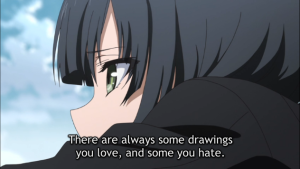
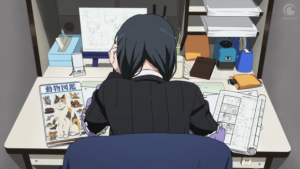


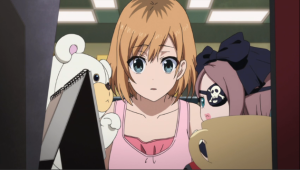
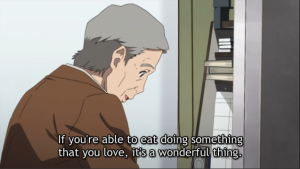
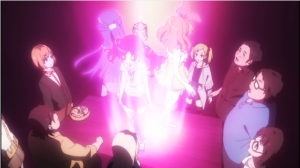
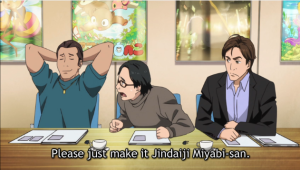
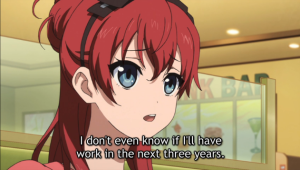
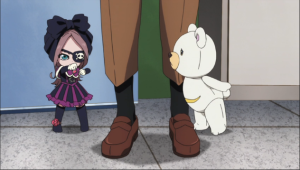


I really enjoyed this anime. I didn’t really have any major complaints, only a few small issues. It definitely had me engaged for the entire time. I cried in episode 23 when Aoi starts to cry. The voice acting right before it really gets me.